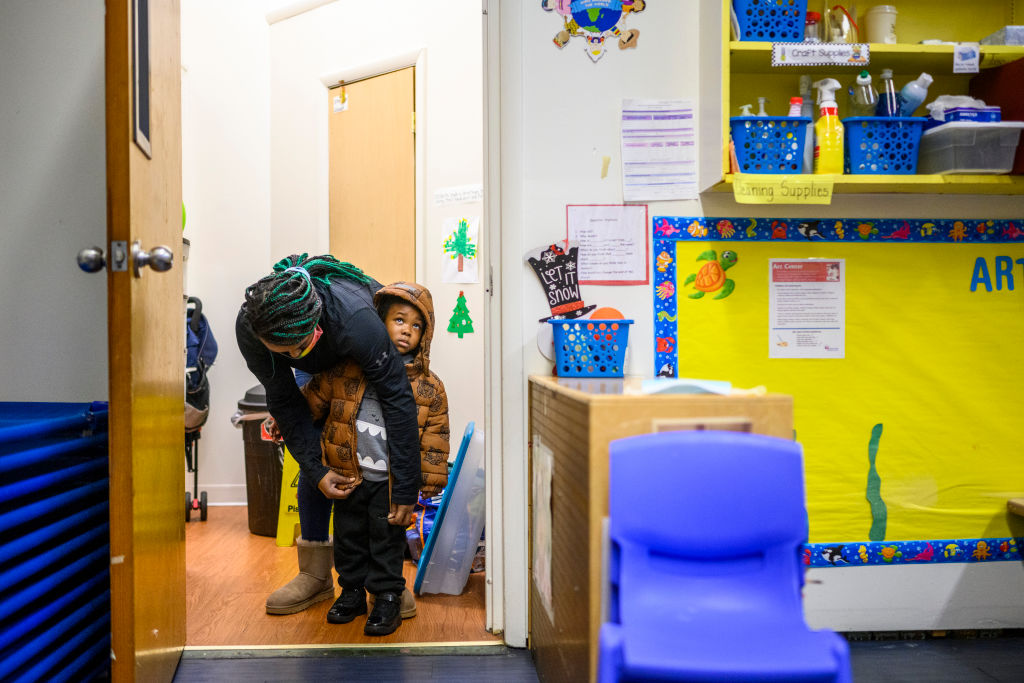The U.S. needs childcare and early learning policies that give every family affordable options to meet their needs and support a diverse childcare workforce, where all providers earn a livable wage.

The largest investment in childcare in American history expired this September. As Congress continues to negotiate a budget deal, the need for $16 billion in emergency childcare funding—requested by President Biden and congressional Democrats—remains top of mind for parents, early educators, childcare owners and directors, and employers across the nation.
The impact of this almost four-month gap in funding is being felt as a steady drip, with tuition increases and staffing shortages preceding program closures in many communities. November data from a new survey of (1,000) childcare providers and families from the RAPID Survey Project and NAEYC shows:
- Twenty-nine percent of families reported childcare tuition increases in the past month, including 38 percent of Black families and 34 percent of Latino families.
- Twenty-eight percent of providers who lost stabilization grants cut educator wages or could not sustain raises.
- Seventy-nine percent of parents looking for care are having difficulty finding openings. Of those, 84 percent say this has impacted their ability to work.
Across the country, childcare investments have strong bipartisan support, polling by The Century Foundation (TCF) and the Morning Consult shows.
- Overall, 62 percent of Americans believe that addressing the childcare cliff should be a top priority for federal policymakers.
- A majority of Democrats (76 percent), Independents (56 percent) and Republicans (51 percent) all believe addressing the childcare cliff should be a top priority for Congress and the White House.
In June 2023, TCF projected that up to 3.2 million children could lose their childcare as a result of the federal childcare funding cliff as federal childcare stabilization funds expired. In Wisconsin, for example, 168 childcare programs have already closed their doors since Sept. 30—impacting approximately 5,000 kids. Washington Post reporter Catherine Rampell did a deep dive to tell the story of the ripple effects of childcare closures: in this case, how one childcare closure impacted one family, which in turn impacted the mother’s employer, who is now having trouble filling her job.
Eleven States Allocate Funding to Childcare
TCF’s new report shines a spotlight on the 11 states and Washington, D.C., that have taken action to directly address the childcare cliff with state funds.
| State | Stabilization Purpose Investments |
|---|---|
| Alaska | One-time funding for childcare worker wage increases |
| California | • Largest-ever rate increases for providers and a pathway to implement provider payment based on the actual cost of providing care • A historic, first-of-its-kind retirement fund • Ongoing funding for health care and training |
| Washington, D.C. | Launched the D.C. Early Childhood Educator Pay Equity Fund, a first-in-the-nation initiative to raise compensation for early childhood educators across the early learning system |
| Illinois | Invests $130 million and additional federal dollars to begin funding for Early Childhood Workforce Compensation Contracts to stabilize operational funding and promote quality in the child care system |
| Kentucky | An additional round of stabilization payments in December 2023 |
| Maine | Doubles the monthly salary stipends for childcare workers from $200 to $400 on average, helping qualified professionals afford to remain in the industry and help providers retain staff |
| Massachusetts | New state funding for the Commonwealth Cares for Children (C3) grants to childcare providers |
| Minnesota | Great Start Compensation Support program, which will support monthly payments to childcare educators to increase compensation and stability in the sector |
| New Hampshire | The state allocated $15 million to support childcare workforce recruitment, retention, and scholarships for early childhood professionals |
| New Mexico | Maintained pandemic-era increases in wages for early educators |
| Vermont | One-time payments to stabilize childcare programs |
| Washington | • Family childcare collective bargaining agreement • Provider grants (among many other supports) |
These funds are successfully bolstering the supply of childcare.
In Massachusetts, which recently approved $475 million in state dollars to continue its stabilization grant program, 47 percent of providers have been able to delay tuition increases and 21 percent of providers were able to reduce tuition. Lauren Kennedy from Neighborhood Villages shared that, “Stabilization grants have been absolutely critical to keeping Massachusetts’ early education and care sector afloat and allowing the Commonwealth to move towards long-term stability and growth.”
In Washington, D.C., more than 3,000 early childhood educators received quarterly supplemental payments, in addition to their salaries, from the D.C. Early Childhood Educator Pay Equity Fund in the 2023 fiscal year. These payments totaled almost $70 million and increased caregiver compensation by 40 percent, supporting staff retention. D.C. early educator Ana Gonzalez told NPR that the Pay Equity Fund is helping her to save to buy a house with her 24-year-old daughter.
In New Mexico, the dedication of state funds to continue the $3-an-hour wage increase originally adopted with American Rescue Plan Act (ARPA) funds, is expected to have a positive impact on the childcare workforce, The state concluded that the Competitive Pay for Professionals (CPP) grant “has had a transformative impact on New Mexico’s childcare workforce” and “addressed longstanding wage issues, recruitment challenges, and professional shortages, particularly in rural areas.”
Majority of U.S. States Are Not Stabilizing Childcare With State Funds
At the same time, across the nation, many of the 39 states that have not invested to continue stabilizing the childcare sector are facing rising tuition and fees for families, staffing shortages, and closures. These different trajectories are expected to only widen in the coming months and years, absent action.
In Florida, providers are sharing stories about having to turn families away because of staffing shortages. The Florida Chamber of Commerce reports that the state misses $911 million annually in tax revenue due to the resulting childcare crisis—in part, because 64 percent of parents of young children missed work or class at least once in the past three months for childcare-related reasons, and 15 percent left a job in the past six months due to childcare issues.
Child Care Aware of Kansas found that, in just the period from when their stabilization grants ended (June 1, 2023, to Sept. 15, 2023), Kansas had a net loss of 43 family childcare programs throughout the state—more than the state had lost over the course of the entire year prior.
In Rhode Island, Beautiful Beginnings Childcare Center serves 150 children, but has a waiting list of 500 and is calling for federal funding to resolve its staffing shortage.
These states are in the company of many others that are experiencing these challenges.
The Need for ‘Ongoing and Permanent’ Childcare Investments
Parent Voices California’s executive director Mary Ignatius said what’s needed is “an infusion of state and federal funding that is ongoing and permanent to match children as they age.”
In the short-term—as President Biden, congressional Democrats and nearly 1,000 organizations across the nation have called for—$16 billion in federal emergency childcare funding is needed to avert a devastating decrease in the supply of care that will disrupt both families and our economy. States must invest additional funding as well.
In the long-term, the United States needs to adopt childcare and early learning policies that give every family affordable and easy-to-access options to meet their needs and support a diverse childcare workforce, where all providers earn a livable wage. This policy would be a win for all—good for the economy, good for children, and good for families.
Up next:
U.S. democracy is at a dangerous inflection point—from the demise of abortion rights, to a lack of pay equity and parental leave, to skyrocketing maternal mortality, and attacks on trans health. Left unchecked, these crises will lead to wider gaps in political participation and representation. For 50 years, Ms. has been forging feminist journalism—reporting, rebelling and truth-telling from the front-lines, championing the Equal Rights Amendment, and centering the stories of those most impacted. With all that’s at stake for equality, we are redoubling our commitment for the next 50 years. In turn, we need your help, Support Ms. today with a donation—any amount that is meaningful to you. For as little as $5 each month, you’ll receive the print magazine along with our e-newsletters, action alerts, and invitations to Ms. Studios events and podcasts. We are grateful for your loyalty and ferocity.





